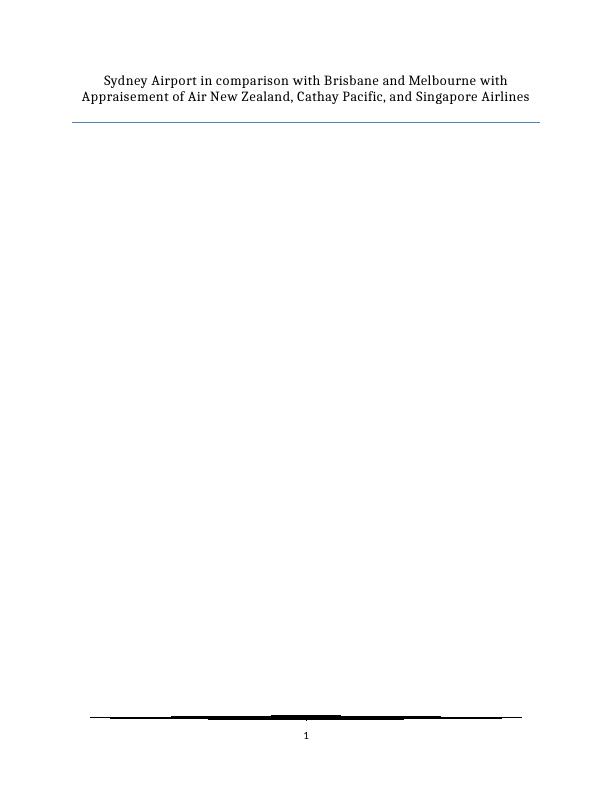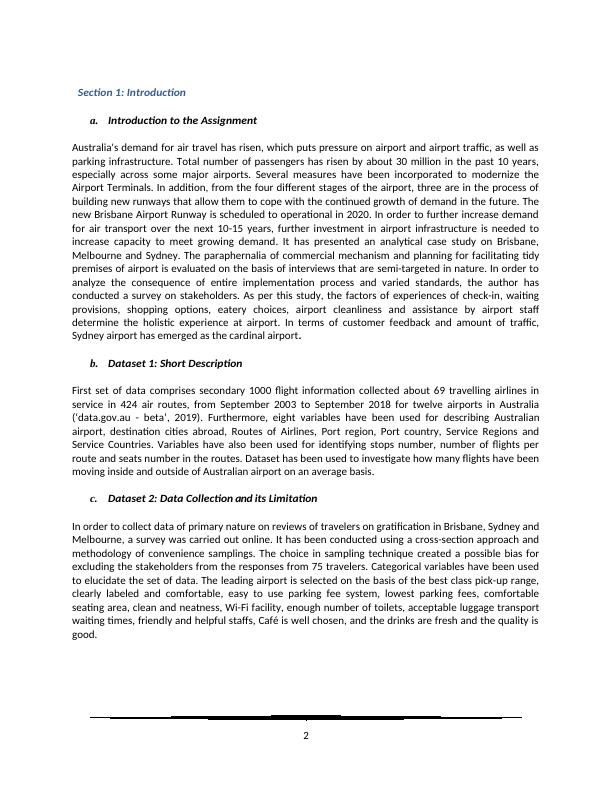Comparison of Sydney, Brisbane and Melbourne Airports with Air New Zealand, Cathay Pacific and Singapore Airlines
Added on 2023-04-25
18 Pages2001 Words490 Views
Sydney Airport in comparison with Brisbane and Melbourne with
Appraisement of Air New Zealand, Cathay Pacific, and Singapore Airlines
1
Appraisement of Air New Zealand, Cathay Pacific, and Singapore Airlines
1

Section 1: Introduction
a. Introduction to the Assignment
Australia's demand for air travel has risen, which puts pressure on airport and airport traffic, as well as
parking infrastructure. Total number of passengers has risen by about 30 million in the past 10 years,
especially across some major airports. Several measures have been incorporated to modernize the
Airport Terminals. In addition, from the four different stages of the airport, three are in the process of
building new runways that allow them to cope with the continued growth of demand in the future. The
new Brisbane Airport Runway is scheduled to operational in 2020. In order to further increase demand
for air transport over the next 10-15 years, further investment in airport infrastructure is needed to
increase capacity to meet growing demand. It has presented an analytical case study on Brisbane,
Melbourne and Sydney. The paraphernalia of commercial mechanism and planning for facilitating tidy
premises of airport is evaluated on the basis of interviews that are semi-targeted in nature. In order to
analyze the consequence of entire implementation process and varied standards, the author has
conducted a survey on stakeholders. As per this study, the factors of experiences of check-in, waiting
provisions, shopping options, eatery choices, airport cleanliness and assistance by airport staff
determine the holistic experience at airport. In terms of customer feedback and amount of traffic,
Sydney airport has emerged as the cardinal airport.
b. Dataset 1: Short Description
First set of data comprises secondary 1000 flight information collected about 69 travelling airlines in
service in 424 air routes, from September 2003 to September 2018 for twelve airports in Australia
(‘data.gov.au - beta’, 2019). Furthermore, eight variables have been used for describing Australian
airport, destination cities abroad, Routes of Airlines, Port region, Port country, Service Regions and
Service Countries. Variables have also been used for identifying stops number, number of flights per
route and seats number in the routes. Dataset has been used to investigate how many flights have been
moving inside and outside of Australian airport on an average basis.
c. Dataset 2: Data Collection and its Limitation
In order to collect data of primary nature on reviews of travelers on gratification in Brisbane, Sydney and
Melbourne, a survey was carried out online. It has been conducted using a cross-section approach and
methodology of convenience samplings. The choice in sampling technique created a possible bias for
excluding the stakeholders from the responses from 75 travelers. Categorical variables have been used
to elucidate the set of data. The leading airport is selected on the basis of the best class pick-up range,
clearly labeled and comfortable, easy to use parking fee system, lowest parking fees, comfortable
seating area, clean and neatness, Wi-Fi facility, enough number of toilets, acceptable luggage transport
waiting times, friendly and helpful staffs, Café is well chosen, and the drinks are fresh and the quality is
good.
2
a. Introduction to the Assignment
Australia's demand for air travel has risen, which puts pressure on airport and airport traffic, as well as
parking infrastructure. Total number of passengers has risen by about 30 million in the past 10 years,
especially across some major airports. Several measures have been incorporated to modernize the
Airport Terminals. In addition, from the four different stages of the airport, three are in the process of
building new runways that allow them to cope with the continued growth of demand in the future. The
new Brisbane Airport Runway is scheduled to operational in 2020. In order to further increase demand
for air transport over the next 10-15 years, further investment in airport infrastructure is needed to
increase capacity to meet growing demand. It has presented an analytical case study on Brisbane,
Melbourne and Sydney. The paraphernalia of commercial mechanism and planning for facilitating tidy
premises of airport is evaluated on the basis of interviews that are semi-targeted in nature. In order to
analyze the consequence of entire implementation process and varied standards, the author has
conducted a survey on stakeholders. As per this study, the factors of experiences of check-in, waiting
provisions, shopping options, eatery choices, airport cleanliness and assistance by airport staff
determine the holistic experience at airport. In terms of customer feedback and amount of traffic,
Sydney airport has emerged as the cardinal airport.
b. Dataset 1: Short Description
First set of data comprises secondary 1000 flight information collected about 69 travelling airlines in
service in 424 air routes, from September 2003 to September 2018 for twelve airports in Australia
(‘data.gov.au - beta’, 2019). Furthermore, eight variables have been used for describing Australian
airport, destination cities abroad, Routes of Airlines, Port region, Port country, Service Regions and
Service Countries. Variables have also been used for identifying stops number, number of flights per
route and seats number in the routes. Dataset has been used to investigate how many flights have been
moving inside and outside of Australian airport on an average basis.
c. Dataset 2: Data Collection and its Limitation
In order to collect data of primary nature on reviews of travelers on gratification in Brisbane, Sydney and
Melbourne, a survey was carried out online. It has been conducted using a cross-section approach and
methodology of convenience samplings. The choice in sampling technique created a possible bias for
excluding the stakeholders from the responses from 75 travelers. Categorical variables have been used
to elucidate the set of data. The leading airport is selected on the basis of the best class pick-up range,
clearly labeled and comfortable, easy to use parking fee system, lowest parking fees, comfortable
seating area, clean and neatness, Wi-Fi facility, enough number of toilets, acceptable luggage transport
waiting times, friendly and helpful staffs, Café is well chosen, and the drinks are fresh and the quality is
good.
2

Section 2: Analysis of All Flights in Dataset 1
a. Shape of the Distribution
Following Figure 1, dispensation for variables of “All flights” was recognized for being extremely right
skewed rightly (S = 1.71) caused by presence of observations in outlier that insinuated traffic congestion
at handful airports and in some months. Sydney, Brisbane, Melbourne, and Perth airports are the
busiest, accommodating flight from 801 routes. 374 flights are operating from Sydney alone, whereas
257 flights are operating from Melbourne and Brisbane has 170 flights routes. Outliers’ presence in
distribution has been the prime cause for a greater quality deviation, especially in Sydney, Brisbane,
Melbourne, and Perth.
Histogram for "All Flights" Variable
Boxplot "All flights" for Australian Cities
3
a. Shape of the Distribution
Following Figure 1, dispensation for variables of “All flights” was recognized for being extremely right
skewed rightly (S = 1.71) caused by presence of observations in outlier that insinuated traffic congestion
at handful airports and in some months. Sydney, Brisbane, Melbourne, and Perth airports are the
busiest, accommodating flight from 801 routes. 374 flights are operating from Sydney alone, whereas
257 flights are operating from Melbourne and Brisbane has 170 flights routes. Outliers’ presence in
distribution has been the prime cause for a greater quality deviation, especially in Sydney, Brisbane,
Melbourne, and Perth.
Histogram for "All Flights" Variable
Boxplot "All flights" for Australian Cities
3

“All Flights” has been the total flights in operation during specific month in a year and on a distinct air
route. Flights on an average basis functioning during a month and on specific route from September
2003 to September 2018 was 24.56 (SD = 20.91). The author further investigated flights calculated on an
average and operating in Australia for a month. Average flights’ number operating in a specific month in
Australia is 150.65 (SD = 88.31).
b. Mean of total flights flew in and out to Australia in a Month
Assumptions for t-test
Normality: “All Flights” was presumed to entail a normalized distribution caused by the sampling
size of 163 months (n>30), by using Theorem of Central Limit.
Observations made were independent and random since the flights were flown between an abroad
city and Australian city in different months.
Histogram for “All Flights” in a month for Australia
Firstly, the assumption was that mean of total flight for each city within the given research time frame
was lesser or same as 30 (H0:
μ≤30
).
It has been examined against right tail alternative supposition, if mean of total flights for each city was
more beyond 30 (HA:
μ>30
).
Confidence intervals of 95% from software “Statkey” with use of 5000 simulation of sample was derived
from average population, which does not include the hypothesized value.
T-test statistic (t = 21.78, p < 0.05) confirmed the result and an important statistical proof rejected the
invalid supposition at level of 5%, accepting the fact that number of flights in a month flying in and out in
Australia is considerably greater than 30.
4
route. Flights on an average basis functioning during a month and on specific route from September
2003 to September 2018 was 24.56 (SD = 20.91). The author further investigated flights calculated on an
average and operating in Australia for a month. Average flights’ number operating in a specific month in
Australia is 150.65 (SD = 88.31).
b. Mean of total flights flew in and out to Australia in a Month
Assumptions for t-test
Normality: “All Flights” was presumed to entail a normalized distribution caused by the sampling
size of 163 months (n>30), by using Theorem of Central Limit.
Observations made were independent and random since the flights were flown between an abroad
city and Australian city in different months.
Histogram for “All Flights” in a month for Australia
Firstly, the assumption was that mean of total flight for each city within the given research time frame
was lesser or same as 30 (H0:
μ≤30
).
It has been examined against right tail alternative supposition, if mean of total flights for each city was
more beyond 30 (HA:
μ>30
).
Confidence intervals of 95% from software “Statkey” with use of 5000 simulation of sample was derived
from average population, which does not include the hypothesized value.
T-test statistic (t = 21.78, p < 0.05) confirmed the result and an important statistical proof rejected the
invalid supposition at level of 5%, accepting the fact that number of flights in a month flying in and out in
Australia is considerably greater than 30.
4

End of preview
Want to access all the pages? Upload your documents or become a member.
Related Documents
Evaluating Airlines Frequencies and Passenger Satisfaction of Australian International Airportslg...
|10
|2222
|238
Analysis of Australian airline datalg...
|12
|1638
|50
Analysis of International Flights in Australialg...
|9
|1734
|256
Airline Analysislg...
|8
|1185
|306
Analysis of Single and Two Variables in Aviation Industry Datasetlg...
|15
|2790
|62
Analysis of Flights Dataset from Deskliblg...
|11
|2460
|55
